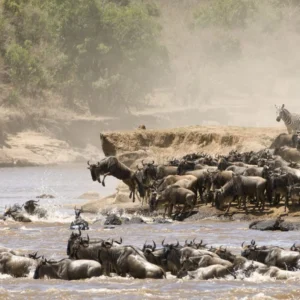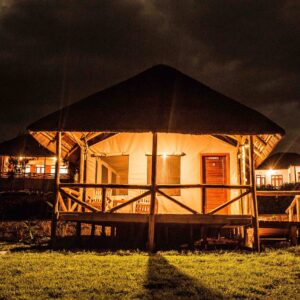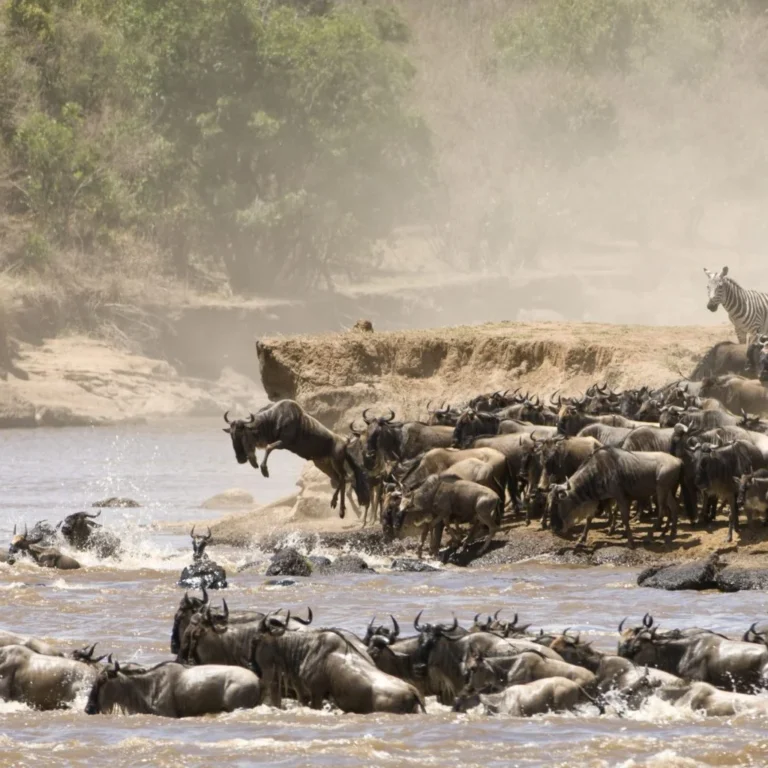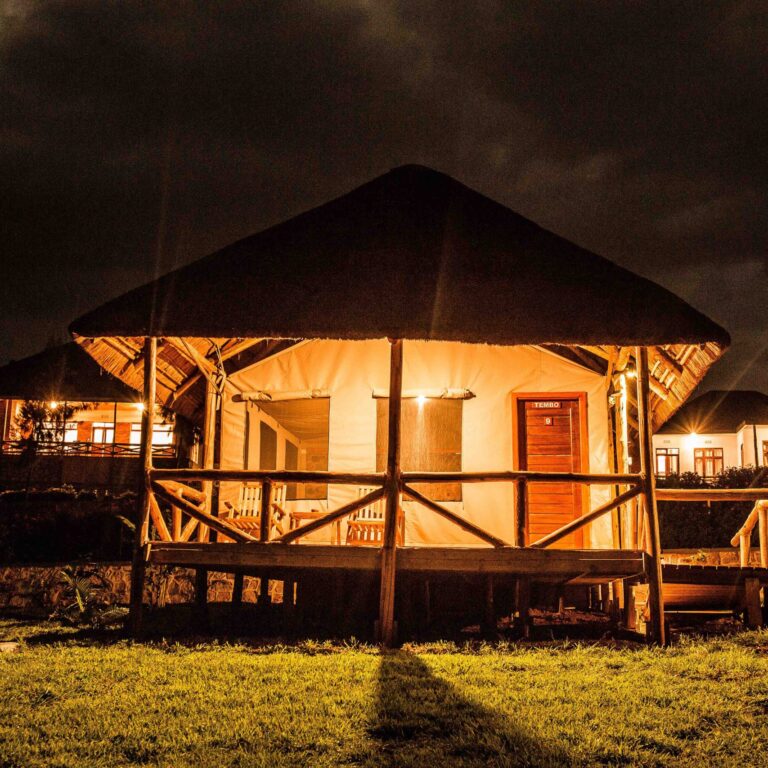Tanzania, a jewel of East Africa, offers a symphony of experiences that captivate every kind of traveler. From the iconic savannahs teeming with wildlife to the sun-kissed beaches of the Indian Ocean and the snow-capped summit of Africa’s highest peak, the country is a veritable playground for adventure, culture, and relaxation. It’s a land where ancient landscapes meet vibrant cultures, creating an unforgettable tapestry of attractions. Tanzania offers a diverse range of tourist attractions and activities. From iconic wildlife safaris to challenging mountain climbs and pristine beach experiences, with highlights. Including the Serengeti National Park for the Great Migration, the Ngorongoro Crater for dense wildlife viewing. Mount Kilimanjaro for peak ascents, and the Zanzibar archipelago for its beautiful beaches and cultural heritage.
1. Serengeti National Park – Rated As Africa’s Best Safari Park
Undoubtedly, the most famous wildlife sanctuary in the world, Serengeti National Park, holds the undisputed title as Africa’s Best Safari Park. It’s endless plains (Serengeti means “endless plains” in Maasai). Home to an astonishing concentration of wildlife. Making it the quintessential safari destination. The park’s main Africa’s most amazing places to visit draw is the Great Migration. An epic annual spectacle where over two million wildebeest, zebras, and gazelles thunder across the savannah in search of greener pastures. Often braving crocodile-infested rivers. This natural phenomenon best places to visit in Africa, occurring year-round in various stages across the Serengeti-Mara ecosystem. Offers unparalleled predator-prey interactions. Beyond the migration, the Serengeti guarantees exceptional game viewing of the “Big Five” (lion, leopard, elephant, rhino, buffalo), alongside cheetahs, giraffes, hippos, and a bewildering array of birdlife. Game drives here are truly immersive, often feeling like you’ve stepped into a wildlife documentary.
2. Ngorongoro Crater – Dramatic Scenery and Tons of Wildlife
Adjacent to the Serengeti lies the Ngorongoro Crater, a breathtaking UNESCO World Heritage Site renowned for its dramatic scenery and tons of wildlife. This massive, unbroken volcanic caldera, often called “Africa’s Garden of Eden,” shelters an extraordinary density of animals. Descending into the crater floor offers a unique safari experience, where you can often spot all of the Big Five in a single day, including the critically endangered black rhino. The diverse habitats within the crater, from open grasslands to acacia woodlands and soda lakes, support a vast array of species in a relatively confined area. The backdrop of the crater walls, often shrouded in mist, adds to the almost mystical ambiance of this natural wonder.
3. Climbing Kilimanjaro – Africa’s Highest Peak
Dominating the northern Tanzanian skyline, Climbing Kilimanjaro is an adventure of a lifetime. Standing at 5,895 meters (19,341 feet), it is Africa’s Highest Peak and the world’s tallest free-standing mountain. While it doesn’t require technical climbing skills. It’s a demanding trek that tests endurance and mental fortitude. The journey takes climbers through five distinct ecological zones – from lush rainforests and alpine deserts to the icy glacial cap at the summit, and cool and unusual things to do in Tanzania. Reaching Uhuru Peak at dawn, witnessing the sunrise over the African continent. An unparalleled sense of achievement and a truly iconic “bucket list” experience.
4. Nyerere (Selous) National Park – Africa’s Largest Wildlife Reserve
In southern Tanzania lies Nyerere (Selous) National Park, formerly the Selous Game Reserve and still widely referred to by its former name. This colossal protected area is Africa’s Largest Wildlife Reserve. It offers a wilder, more remote safari experience than its northern counterparts. Its vastness means fewer crowds and a greater sense of untouched wilderness. Nyerere is renowned for its large populations of elephants, buffalo, and wild dogs (painted wolves), as well as significant lion and leopard populations. A unique feature of Nyerere is the opportunity for boat safaris along the Rufiji River. Offering a different perspective on the wildlife, particularly crocodiles, hippos, and a plethora of birdlife. Walking safaris are also a highlight, providing an immersive experience on foot.
5. Zanzibar – An Indian Ocean Island Rich in Culture and History
After the dust and excitement of the safari, the idyllic archipelago of Zanzibar offers a perfect tropical escape. This Indian Ocean island is rich in culture and history, a melting pot of African, Arab, Indian, and European influences top best tourist attractions in Tanzania. Stone Town, a UNESCO World Heritage Site, is its beating heart, a labyrinth of narrow alleys, bustling bazaars, intricately carved wooden doors, and historic buildings that whisper tales of sultans and spice traders. Beyond its historical charm, Zanzibar boasts some of the world’s most breathtaking white-sand beaches. Fringed by swaying palm trees and clear turquoise waters, ideal for swimming, snorkeling, diving, and simply unwinding.
6. Tarangire National Park
Tarangire National Park is a gem in Tanzania’s northern safari circuit. Often visited as part of a longer itinerary. It is particularly famous for its enormous elephant herds and the majestic baobab trees that dot its landscape. During the dry season (June to October), the Tarangire River becomes the park’s lifeline, attracting vast concentrations of wildlife. Including wildebeest, zebras, giraffes, and various predators. Its unique topography and diverse birdlife (over 550 species recorded) make it a distinct and rewarding safari destination.
7. Lake Manyara National Park
Another highlight of the northern circuit. Lake Manyara National Park is a compact yet incredibly diverse park. It’s famous for the best places to visit in Tanzania – Destinations for its tree-climbing lions, a rare behavior for these big cats, often seen lounging in the branches of acacia trees. The park encompasses a narrow strip of land between the Great Rift Valley escarpment and Lake Manyara itself. The shallow, alkaline lake attracts huge flocks of flamingos and other waterfowl. Creating a stunning pink spectacle must-see attraction in Tanzania. The park’s varied habitats, from groundwater forest to open savannah and hot springs, support a wide range of wildlife. Including large troops of baboons, elephants, and hippos.
8. Katavi National Park – Relatively Untouched Wildlife Paradise
For the truly adventurous and those seeking an off-the-beaten-path experience. Katavi National Park in western Tanzania is a relatively untouched wildlife paradise. Remote and less visited than the northern parks. Katavi offers an authentic wilderness experience. During the dry season, the Katuma River and its associated floodplains become vital water sources. Leading to incredible concentrations of hippos (often hundreds crammed into dwindling pools) and crocodiles. It’s also known for its massive herds of buffalo and elephants, and excellent predator sightings. The remote nature of Katavi means limited infrastructure but promises an unparalleled sense of solitude and raw nature.
9. Ruaha National Park – Tanzania’s Famous Wilderness Area
Ruaha National Park, located in the heart of Tanzania, is the country’s largest national park and a truly famous wilderness area. It offers a vast, rugged, and diverse landscape, including miombo woodlands, arid plains, and the dramatic Ruaha River. This park is particularly renowned for its large lion population (one of the biggest in Africa), as well as significant numbers of elephants, greater and lesser kudus, sable and roan antelopes. Its remoteness contributes to a more exclusive safari experience. Ideal for those seeking a less crowded, more immersive encounter with the wild.
10. Pemba – The ‘Green Island’ of East Africa
North of Zanzibar lies Pemba, often referred to as the ‘Green Island’ of East Africa due to its lush, hilly terrain covered in spice plantations and dense forests. Less developed and more tranquil than its southern neighbor. Pemba offers a serene escape. It’s a haven for divers and snorkelers, with pristine coral reefs, abundant marine life, and excellent visibility. Beyond the underwater world, visitors can explore ancient ruins, learn about spice farming, or simply relax in its uncrowded, picturesque bays. It provides an authentic and peaceful island experience.
11. Mafia Island – A Beach Paradise With Superb Diving
South of Dar es Salaam, Mafia Island is a tranquil beach paradise with superb diving. Part of the Mafia Island Marine Park, it’s a world-class destination for marine enthusiasts. Its untouched coral reefs are home to an incredible array of fish species, colorful corals, and large marine animals. Including whale sharks (seasonal, typically October to March), which can be snorkeled with. Mafia offers a more laid-back and intimate island experience than Zanzibar. Focusing heavily on its pristine underwater environment and authentic coastal village life.
12. Cultural Experiences: Beyond the Wild and Waves
Tanzania’s rich tapestry of wildlife and natural beauty is complemented by its equally vibrant and diverse cultural experiences. With over 120 distinct ethnic groups, the country offers unique opportunities to connect with local communities and learn about their traditions, history, and daily lives. These cultural encounters not only enrich your understanding of Tanzania but also directly support local communities through sustainable tourism initiatives. Ensuring that the benefits of your visit reach those who call this remarkable country home.
Maasai Village Visits. Iconic for their distinctive red shukas and semi-nomadic pastoralist lifestyle, the Maasai are one of Tanzania’s most recognizable tribes. Visiting a traditional boma (homestead) allows you to witness their vibrant dances, learn about their cattle-centric culture, and observe their unique beadwork. Many Maasai communities near the northern safari parks, especially in the Ngorongoro Conservation Area, welcome visitors, offering insights into their age-old traditions.
Hadzabe and Datoga Encounters (Lake Eyasi). Near Lake Eyasi, you can engage with the Hadzabe, one of Africa’s last remaining true hunter-gatherer tribes. This extraordinary experience involves joining them on a morning hunt, learning about their tracking skills, archery, and foraging for wild berries and honey. Nearby, the Datoga, a pastoralist and blacksmith tribe, offer insights into their crafts and way of life.
Chagga Cultural Tours (Kilimanjaro Slopes). On the fertile slopes of Mount Kilimanjaro, the Chagga people offer a glimpse into their agricultural traditions. You can visit coffee plantations, learn about the process from bean to cup, explore traditional Chagga shambas (farms), and even sample mbege, their traditional banana beer. Some tours include visits to underground tunnels used as hiding places during tribal wars.
Mto wa Mbu Village. Located near Lake Manyara, Mto wa Mbu is a unique cultural melting pot, home to over 120 different tribes. A walking tour here reveals diverse agricultural practices (including banana and rice paddies), local markets, and various artisan workshops, providing a snapshot of Tanzania’s ethnic diversity in one place.
Stone Town Walking Tour (Zanzibar). Beyond its beaches, Zanzibar’s Stone Town is a living museum. A guided walk through its narrow, winding alleys unveils centuries of Swahili history, Arab influence, and the island’s poignant past as a spice and slave trading hub. You’ll see intricately carved doors, historical buildings like the House of Wonders, and bustling markets.
Local Markets and Cooking Classes. Immerse yourself in the local culinary scene by visiting vibrant local markets in towns like Arusha or Dar es Salaam. Some cultural programs offer cooking classes where you can learn to prepare traditional Tanzanian dishes like ugali, pilau, or coastal seafood curries.
From the thundering plains of the Serengeti to the tranquil depths off Mafia Island, Tanzania offers an unparalleled spectrum of tourist attractions. It’s a destination where every day brings a new adventure, a fresh perspective, and a deeper connection to the wild heart of Africa.






